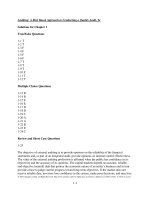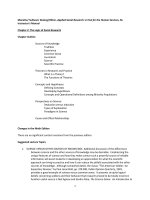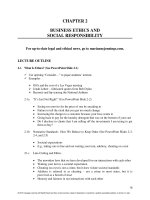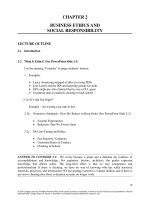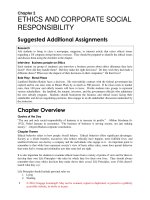Test bank and solution manual of social work and social welfare an inroduction 8e (2)
Bạn đang xem bản rút gọn của tài liệu. Xem và tải ngay bản đầy đủ của tài liệu tại đây (351.17 KB, 3 trang )
PART 1 – Understanding Social Work and Social Welfare
Chapter 2: Social Work and Other Helping Professions
This chapter explores the relationships between social welfare as a broad system intended to
maintain the well-being of individuals within a society and the profession of social work. A brief
history of the social work profession is provided, emphasizing the contributions of the settlement
house movement and Charity Organization Societies. Underpinnings of the profession,
including its values base and the NASW Code of Ethics, are introduced. The discussion explores
the diverse roles and functions of social work professionals, contrasting the profession of social
work with other helping professions and examining ways they can work together. For those
interested in becoming social workers, the chapter explores educational opportunities at the
micro and macro levels and indicates educational pathways and credentialing for various roles.
The importance of self-care is also stressed. Material in this chapter provides the instructor with
an excellent opportunity to present and discuss the relationship between the latest Educational
Policy and Accreditation Standards (EPAS) and the social work curriculum at both the
Bachelor’s and Master’s level, as well as the role the EPAS play in ensuring the quality and
consistency of social programs at both the Bachelor’s and Master’s level. [EP 2.1.1c, 2.1.8b,
2.1.9b]
ACTIVITIES
The instructor may want to use one or more of these activities with students to reinforce their
understanding of the content covered in the chapter as well as to give the instructor insight as to
how well students are processing that information.
Activity 1
This activity can be used with students individually or in small groups. Have each group select
one of the social issues discussed in this text (e.g., health care, homelessness, child maltreatment,
poverty). Drawing from content in Chapter 2, have students identify specific tasks that social
workers engaged in various roles might undertake to address the issue. This is a good way to
help students see the diversity of the profession and contrast various roles social workers can
play in working with individuals, families, groups, organizations, communities, and as policy
advocates and researchers. You may want to have a panel of social work practitioners engaged in
these various roles come to discuss their experiences. Be sure to leave some time at the end of
the panel discussion for questions from the students. [EP 2.1.1a, c]
Activity 2
Obtain a copy of the latest revision of the NASW Code of Ethics. Have students explore how the
Code shapes the ways social workers function in their relationships with clients and other
professionals. Break students into small groups and have them use the Code to discuss vignettes
of ethical dilemmas a social worker might experience. [EP 2.1.2a, b]
Activity 3
Have students “job shadow” or interview a social worker and a member of at least one of the
other helping professions discussed in this chapter and make a list of the similarities and
differences in the two professions. [EP 2.1.1a, c; 2.1.4d, 2.1.8a, b]
Instructor’s Manual, Chapter 2
Activity 4
Either in small groups or individually, have students access the NASW website and gain
information about a field of social work practice in which they are interested. If there is time,
have them use other internet sources to gain additional information about this field. Use student
findings and questions to generate class discussion about the diversity of the profession. [EP
2.1.1a, c; 2.1.8a, b]
Activity 5
Point out that there have been many social work pioneers since the profession was born,
including many social workers of color. (There are videos on Jane Addams and the history of
the profession that can be used to guide this activity.) Have students access the NASW website
on social work pioneers ( Ask each student (or
small groups of students) to access information on one pioneer and share that individual’s
contributions to the profession. You can assign pioneers, incorporating diversity, pioneers from
your state or university, etc. as part of this assignment. [EP 2.1.1a, c; 2.1.4d; 2.1.8a, b]
Discussion Questions
1.
What is meant by the term opportunity structure? Give three examples of how genetics
and heredity, socialization, cultural differences, and environmental factors shape an
individual’s opportunity structure. [EP 2.1.3a; PG 21-22]
2.
What are values? Explain the values on which the social work profession is based. How
do values relate to ethics? Give three examples to support your response. [EP 2.1.2a, b;
PG 25-26]
3.
Describe each of the following social work practice methods and give two examples of
each: social work with individuals and families (casework); social work with groups
(group work); community organization; social work research; and social work
administration and planning. In what ways are these methods similar? [EP 2.1.1a, c;
2.1.8a; PG 27-28]
4.
In what ways is a code of ethics important for a profession? How often do you think a
code of ethics should be reviewed for potential revisions? What conditions would trigger
a code revision? What would you do if you had to work with another profession whose
code of ethics is not in sync with the NASW Code of Ethics? [EP 2.1.2a, b]
5.
Why do you think self-care is important for social workers and other helping
professionals? If you became a social worker, in what types of self-care would you
engage? What types of self-care will you engage in as you take this course and why?
6.
Compare the roles of social workers discussed in this chapter. Which roles would be
most challenging and why? Select a field of practice or a social work issue of importance
to you. What social work roles would you use to address this issue/assist clients?
Instructor’s Manual, Chapter 2
7.
Choose one of the helping professions discussed in this chapter other than social work
and then choose a social welfare issue of importance to you. Compare the roles a social
worker and the other helping professional might play in addressing this issue.
